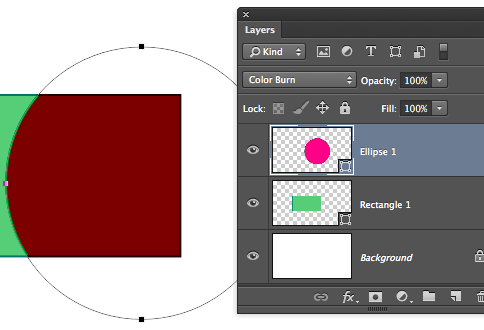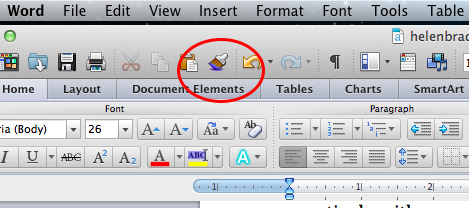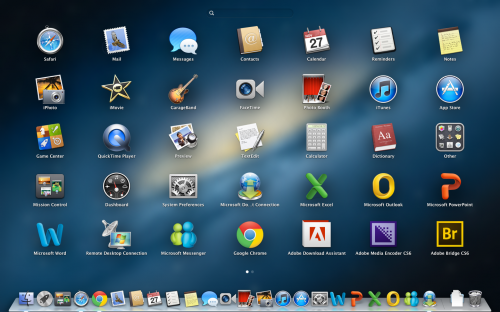Monday, March 31st, 2014

image credit ©ezza116, istockphoto.com
Learn to place guides in Illustrator in the position you want them to appear
Sometimes the differences between Illustrator and Photoshop are really annoying. In Photoshop it is simple to place guides in exactly the position you want them to appear but in Illustrator it isn’t easy at all.
I want to create a square document with guides half way vertically and horizontally so, I’ll start with a new document of a fixed and known size such as 1000 x 1000.
Then choose View > Rulers > Show Rulers so you can see the rulers top and left. With the Selection tool selected, click and drag on the ruler and drag a guide into position. You probably won’t be able to get it exact but that’s ok for now. You can go ahead and drag a guide from the other ruler too.
Guides are, by default, locked so you need to unlock them to move them. Choose View > Guides > Lock Guides to disable the check mark. Now you can drag the guide into position. On the Tool options bar you will see values for X and Y. For the vertical guide, X should be half your document width – in my case 500 and for the horizontal guide the Y value should be 500.

If you open the Layer palette you will see that guides are objects in the current layer. This means that you can click on a guide to select it in the Layer palette and use the tools at the top of the screen to align the guide. So, clicking on it and choosing Horizontal Align Center will center the vertical guide and Vertical Align Center will center a Horizontal guide.
Once your guides are in position, choose View > Guides > Lock Guides to lock them so they won’t move. On this same submenu you can hide guides – this locks them when they are unhidden again or clear guides to remove them from the document entirely.

Other handy tricks include being able to create a vertical guide by dragging down from the top ruler and hold Alt or Option to change if from horizontal to vertical.
You can make new guides (but not existing ones) snap to dividers on the rulers if you hold Shift as you draw them by dragging down from the ruler.
Helen Bradley
Helen Bradley
Labels: center guide, clear guide, create guide, guides, hide guide, Illustrator, lock guide, ruler., unlock guide
Categories:Illustrator, iPad, Mac, Windows
posted by Helen Bradley @ 4:26 pmNo Comments links to this post
Saturday, March 15th, 2014

scroll through blend modes on the mac
by Helen Bradley
Learn the keystrokes that help you quickly scroll through blend modes in Photoshop on the PC and Mac
On the PC, being able to scroll through the blend modes in the Layers palette is a simple as selecting one blend mode in the list then use the Up Arrow and Down Arrow key to go from one to the next.
On the Mac, it isn’t as easy but it (thankfully), can be done.
On the Mac, click in the Blend Modes list and select a blend mode. Then use the Shift + + or Shift + – keys to scroll up and down the list. Unlike on the PC, the Mac keys roll you around the list so, when you reach the bottom and press Shift + + once more you go right back to the top. Neat huh?
Helen Bradley
Labels: blend modes, keyboard shortcut, layer palette, mac, pc, scroll, scroll blend modes
Categories:Mac, photography, Windows
posted by Helen Bradley @ 5:44 pmNo Comments links to this post
Friday, January 31st, 2014
Memo to my Mac – Don’t go to sleep on me!
Hmmm me and my MacBook Air are getting along pretty well but some things still bug me from time to time.
One is the display dim time. You see it seems like I just look away and all of a sudden the Mac has gone elsewhere – the screen turns off and I have to wake it back up and enter my password.
Right now I am trying to download some software so this is getting pretty annoying. I want to be able to see the progress without having to the Mac up all the time. This constant jiggling the touchpad and entering a password is becoming frustrating.
Seems like there are a couple of settings needing changing. One is in Settings > Security & Privacy. If I set the Require Password value to something more than Immediately I will get some leeway in having to enter my password all the time. I set this to 1 hour. But, the screen is still dimmed after only a minute or so. That setting is in Settings > Energy Saver – there you can set the Display Sleep – mine was set to 1.5 minutes – I ramped that up to 1 hour.
So now my Mac doesn’t go to sleep when I am downloading stuff on it and working on another computer and I don’t have to enter my password like every few minutes. In short, life is a lot simpler.
Hope this helps you and your Mac to be friends again?
Helen Bradley
Labels: dim, energy saver, mac, password, security and privacy, settings, sleep
Categories:Mac
posted by Helen Bradley @ 12:48 pmNo Comments links to this post
Saturday, January 11th, 2014
How to display your desktop – hiding all open programs on the Mac
I am in ‘traveling with my Mac mode’ – I have a MacBook Air and it is so light and thin that it makes a great traveling companion – sort of like having an oversize iPad that runs Illustrator, Photoshop and Lightroom.
BUT, and there are some big buts! I use a desktop PC so little things on the Mac bite me because I simply don’t have the knowledge at my fingertips. In the last couple of days the issue has been the desktop – I need to get to some files saved there but there is all this stuff in the way. Turns out there is a shortcut key you can use – F11 – if you’re on a notebook you’ll need to use the Fn function key with this so it is Fn + F11 but that’s all you need to hide everything and show your desktop.
Now I can take my screenshots Command + Shift + 3 then hide the junk so I can see the image to drag and drop it into a Word document or into Photoshop.
Yeah! Me and my Mac are friends again.
Helen Bradley
Labels: hide apps, hide programs, mac, macbook, macbook air, view desktop, windows + D
Categories:Mac
posted by Helen Bradley @ 10:01 am1 Comment links to this post
Thursday, January 9th, 2014

It’s actually not missing but it’s not where you expect to find it either.
I use Word on the PC every day and on the Mac only when I am traveling – I love my MacBook Air with its solid state drive – it’s light and an easy traveling companion.
What I don’t like is having to work out all the curly questions you have when things work differently in one operating system to another. Cue today’s issue. I was copying and pasting content from my website into Word on the Mac and I needed to remove the formatting – well I found the Clear Formatting button sort of where I expected it to be on the ribbon.
But when it came to copying a format from one piece of text to another I got stumped. You see the Format Painter isn’t on the ribbon where you expect it to be if you’re used to using Word on the PC. In fact Word on the Mac is a totally different animal.
To find the Format Painter look upwards – up from the ribbon, up from the ribbon tabs and up to what we Windows folk would call the QAT or Quick Access Toolbar. On that toolbar of tools in Word on the Mac is the Format Painter. Click the text to copy the format from, click the Format Painter and then click the text to paint it onto. It’s a simple process BUT you have to find the Format Painter button first!
Hopefully this helps you!
Helen Bradley
Labels: copy formats, format painter, mac, Microsoft Word, missing icon, ms word, osx, Ribbon, Word
Categories:Mac, office
posted by Helen Bradley @ 11:09 am1 Comment links to this post
Monday, April 22nd, 2013

Learn how to enlarge images from iPhoto – because it won’t do it for you!
If you try to export an image from iPhoto on the Mac you’ll be invited to resize it on export. Funny thing is that even if you ask for the size to be larger than the original iPhoto won’t warn you it is about to ignore your request – seriously! It happily takes the size you ask for and, if it is bigger than the original, it exports the image at the original size but doesn’t tell you it did so. So you can think you’ve been successful but you have not.
In short, you can’t enlarge or upsize an image from iPhoto. So here’s a simple solution – I use PIXizer.com. So, start from inside iPhoto, select an image and then select File > Export.

Then select to export the image as a JPEG maximum quality and leave the size set to Full Size – ie the original image size.

Then export the image to your desktop or somewhere else it will be easy to find.
Launch a browser and head to PIXizer.com.

Click Choose File and choose a file to upload and use the tabbed panels to choose the quality and image size. When you click to Preview Image the image is uploaded and resized. You can then click to download it and it will download automatically to your download folder.
I like the efficiency of PIXizer – it would be nice if iPhoto actually enlarged images but since it won’t – I now have a free and quick and easy solution when I need a quick image enlargement.
Helen Bradley
Helen Bradley
Labels: enlarge, export from iphoto, free enlarge photos on the web, image, iphoto, iphoto won't enlarge image, photo, PIXizer, resize, upsize
Categories:Mac, photography
posted by Helen Bradley @ 5:32 amNo Comments links to this post
Tuesday, April 16th, 2013

Understand the limits of the Photo Stream and how to save images from it so they aren’t removed from your iPad or iPhone
Sometimes you may know that you had some images on your iPad or iPhone but suddenly you find that they’ve gone.
This happens to me when I drop some images into my Photo Stream on my Windows PC that I want to use on my iPad. I drop images into the Uploads folder on my PC and, via the iCloud, they are synced automatically to my iPad. I know the images got there safely – I put them there months ago and I know that I saw them on my iPad but suddenly today they aren’t there. Confusing? Happened to you? It probably has and here is the explanation as to why they disappear and how to stop them from doing so.
The issue is the Photo Stream. The photo stream on the iPad and iPhone only store the last one thousand images – if you shoot lots of images and, say have your iPhone and iPad synced then you’ll run out of space pretty quickly. When you do then images are knocked out of the Photo Stream to make room for more recent ones.
The issue doesn’t happen on your Mac or PC because they have plenty of space so photos in your Photo Stream folders there are always there – it is just a protection against junking up your iPhone or iPad with ‘stuff’.
So, what do you do when you want to keep some of the images from your Photo Stream permanently and you don’t want to lose them? The answer is to move them to an album or to your Camera Roll. The images in your camera roll and in albums are there to stay. And just to clarify, you don’t have to move images from the Photo stream that you captured with that device – because images you capture on the iPad for example are in the Camera Roll and stay there. The images you want to save are those that get synced to the iPad via iCloud from other devices such as your iPhone or PC or Mac – they are the ones that only hang around for a short time.
How to move images from your Photo Stream to an album
So, to move a lot of images to an album (an easy solution for lots of images that you want to save to somewhere that isolates them from all your other images), tap Photos, tap Photo Stream, tap My Photo Stream.

You should now see all the thumbnails of images in your photo stream. Then tap Edit.

In this mode you can now tap the images that you want to save – each of them should have a blue checkmark on them. Now tap Save and choose to Save to an Existing Album or Save to New Album.

I have an album for images I want to edit and play with on the iPad called Editable Pix so I typically tap that to select it. This lets me store those images so they are isolated from all the other images in my Camera Roll.

How to move images from your Photo Stream to your Camera Roll
It is also possible to save photos from the Photo Stream to the Camera Roll. The advantage of this is that they are in the Camera Roll itself and in some situations that might work best for you.
To do this, again tap Photos, tap Photo Stream, tap My Photo Stream so you see all the thumbnails of images in your photo stream. Again tap Edit. In this mode you can now tap the images that you want to save – each of them should have a blue checkmark on them. Now, tap the Share button in the top left of the screen:

And choose Save to Camera Roll. (It is very confusing that these two processes that really are so similar are handled so differently in iOS6).

How to save one image from your Photo Stream to your Camera Roll
Now, if you just want to save one image from the Photo Stream to the Camera Roll, tap Photos, tap Photo Stream, tap My Photo Stream so you see all the thumbnails of images in your photo stream. Tap the one image that you want to copy to the Camera Roll so it is showing full screen. Now tap the Send to button that is a box with an arrow coming out of it in the top right of the screen and choose Save to Camera Roll from the menu.

Now you will never again lose images off your iPhone or iPad that you really want to keep.
Helen Bradley
Labels: album, camera roll, copy, icloud, ipad, iPhone, mac, move, pc, photo stream, photos disappear, photostream, save, sync, upload
Categories:iPad, Mac, photography
posted by Helen Bradley @ 9:00 am1 Comment links to this post
Friday, March 22nd, 2013

Learn how to download photos from your iPad or iPhone to your Mac
I’ve been using iCloud on the PC for a while now to sync photos from my iPad to my PC and it works well. On my new Mac, however, I had a problem, you see the feature is built in so you don’t have to install it – but you do have to find it! Here’s how:
1. Assuming you already have an iPad or iPhone and you have been taking photos with it, then you want to get them to your Mac. Start on your iPad and make sure it is set to sync. Do this in Settings – scroll to find Photos & Camera and make sure that My Photo Stream is turned on. This means that when you are on a wifi connection your photo stream will be synced with iCloud.

Note:
The photo stream has some limits. One is that iCloud itself only stores images for 30 days so after that they disappear. However provided you are connected via wifi on a regular basis these will be synced frequently so that won’t be a big issue.
On a device like the iPad and iPhone the photo stream will only contain those most recent 1,000 images – older ones are removed. This is because you have less space on your iPad and iPhone than on a Mac or PC. Remember too that the photo stream contains images from the iPad/iPhone and from your Mac or PC so this 1,000 image limitation is for images from all devices in total, so it’s not as big as it might seem.
On the PC that is less of a problem because you have a special Photo stream folder that you put images into to sync them, so you know how many you are putting there. It is more of an issue on the Mac because the process is more automated so you have to be mindful of what is happening. On your Mac or PC all the images from your Photo stream are stored – because there is more storage available on them.
2. To set up the Mac. You need to click iPhoto to launch it and then click Web: Photo Stream and turn this on.

3. Now, if you are connected via wifi you can wait as your photo stream downloads automatically for you otherwise this will happen automatically next time you are connected.
Once images are downloaded to iPhoto they will be added to the Photos folder so even if you turn off Photo Stream at some time the images that are already downloaded will have be stored there permanently.
Helen Bradley
Labels: copy photos to iphone, download, icloud, images, ipad, iPhone, iphoto, move photos to ipad, photo stream, photos, photostream, pictures, sync, upload
Categories:iPad, Mac, photography
posted by Helen Bradley @ 5:38 amNo Comments links to this post
Sunday, March 17th, 2013

See how to upload images from your Mac to your iPad or iPhone
Sometimes you will get images on your Mac that you want to share with your devices such as your iPad or iPhone. To do this you can add them to your photo stream and they will be synced automatically next time you are connected using a wifi connection.
To do this, from inside iPhoto, click the image(s) to add to the photo stream then click the Share option on the toolbar, click Photo Stream > My Photo Stream. The images will be uploaded to your photo stream and then downloaded to other devices when they next update via a wifi connection.

Of course, for this to work the images have to be in iPhoto. If an image is not, for example, it is on the desktop – you can add it to iPhoto by dragging and dropping it into iPhoto and then add it to your photo stream.
Of course if you have your iPhoto set up to automatically send all new images to your photo stream the very process of adding images to iPhoto will add them to your Photo Stream. To do this in iPhoto, choose iPhoto > Edit Preferences > Photo Stream and, under My Photo Stream (which should already be enabled), check Automatic Import.

Helen Bradley
Labels: copy, get images to ipad from mac, ipad, iPhone, iphoto, mac, move, photo stream, photos, photostream, sync, upload
Categories:iPad, Mac, photography
posted by Helen Bradley @ 5:35 am1 Comment links to this post
Tuesday, November 27th, 2012

Ok, yep, I just bought a brand spanking new MacAir – for a few reasons and one is its weight – it is so so light with its solid state drive. I got a 13 inch one with 8GB ram and 256 Gb drive but on reflection I really think I could have done with the 11.6 version except this larger screen does have a higher resolution.
So enough of my new toy – it’s a while since I’ve owned a Mac and while some things are all so familiar, many are not. Here’s my take on what I’ve learned so far.
1 Download Chrome and use it – I don’t like Safari much at all.
2 When you install Office 2011 Mac you’ll get an error asking you to close Safari. The red button in the top corner might close the screen but it doesn’t actually close the program – go figure! Instead you need to find it on the dock and right click it and choose Quit. Oh! your mouse only has one button? – Yikes! The shortcut is to Control + Click on the Safari button and then you can choose Quit. Then Office installs just fine.
3 Weather! If you swipe to the right (or press Control + Right Arrow) a cute little desktop appears with a calculator, calendar, weather and clock. Problem is that the weather is inevitably going to be the wrong city. Well check and look for the little i icon – it is the information/settings option. Click it and you can select the weather for the place you are interested in viewing.
4 Keychain – it’s a tool for storing passwords so you don’t have to enter them every time – but the dialog doesn’t make it clear exactly what it does and it talks about ‘private’ information so it looks scarier than it is! Bottom line – I use it.
5 Open a web page in a new tab – Command + click on the link.
6 Take a shot of the Mac Screen – Command +Shift+3: Capture the screen to a file on the desktop – if you add Control to this the capture goes to the clipboard instead. Or Command+Shift+4 to select an area to be saved as a file on the desktop – add Control to save it to the Clipboard. There are other options but that’s the basics to remember.
7 Can’t find your newly installed Mac apps – click the Launch Pad icon and you’ll see everything that is installed. Once you know how to do this you can start cleaning up the dock and get rid of the things you don’t use to make way for those that you do – but that’s another day’s post!
Helen Bradley
Labels: change weather on a mac, chrome, keychain, mac, macair, open web page, safari error installing office 2011, screen capture, screen shot
Categories:Mac
posted by Helen Bradley @ 6:37 amNo Comments links to this post
























